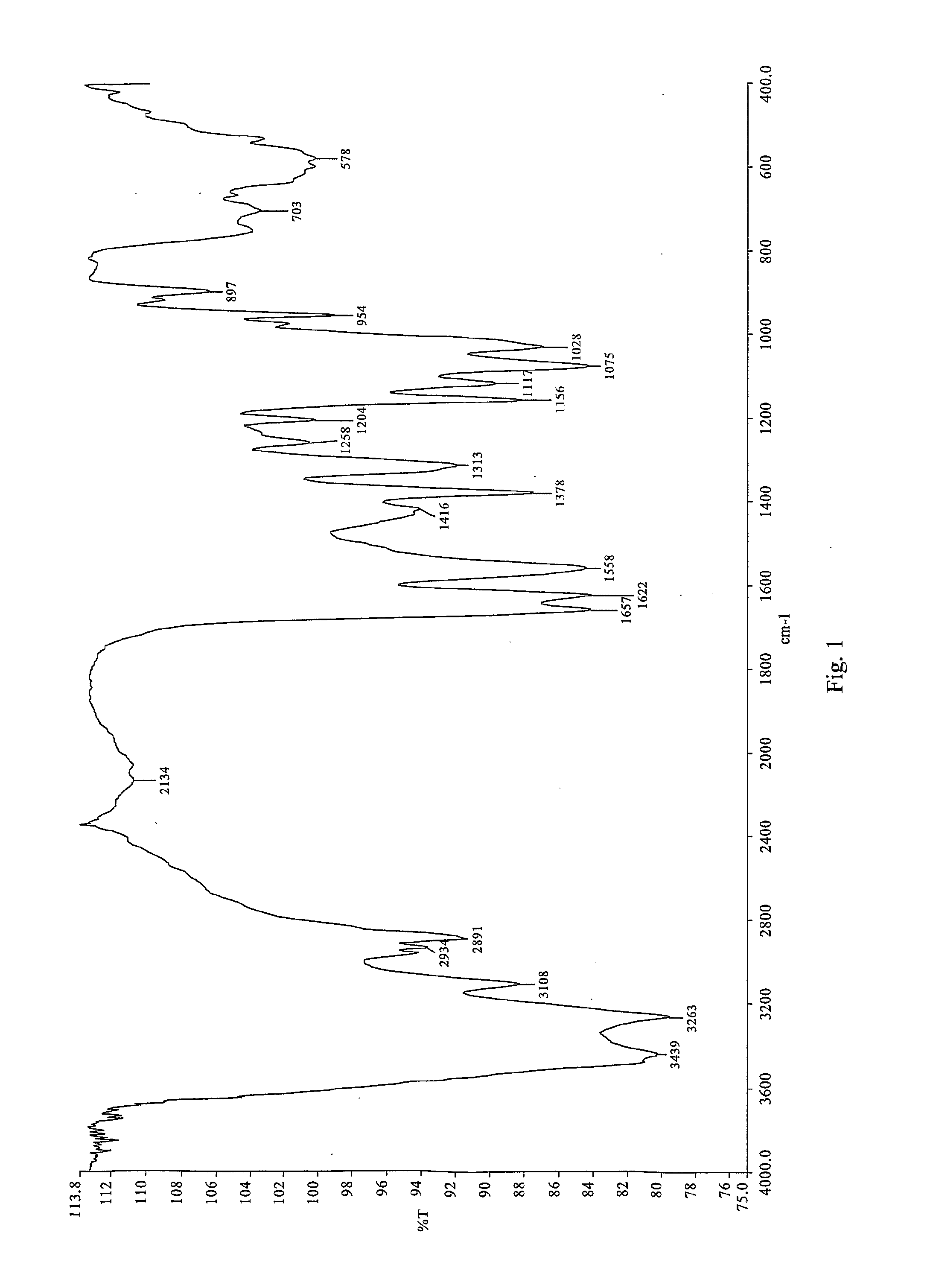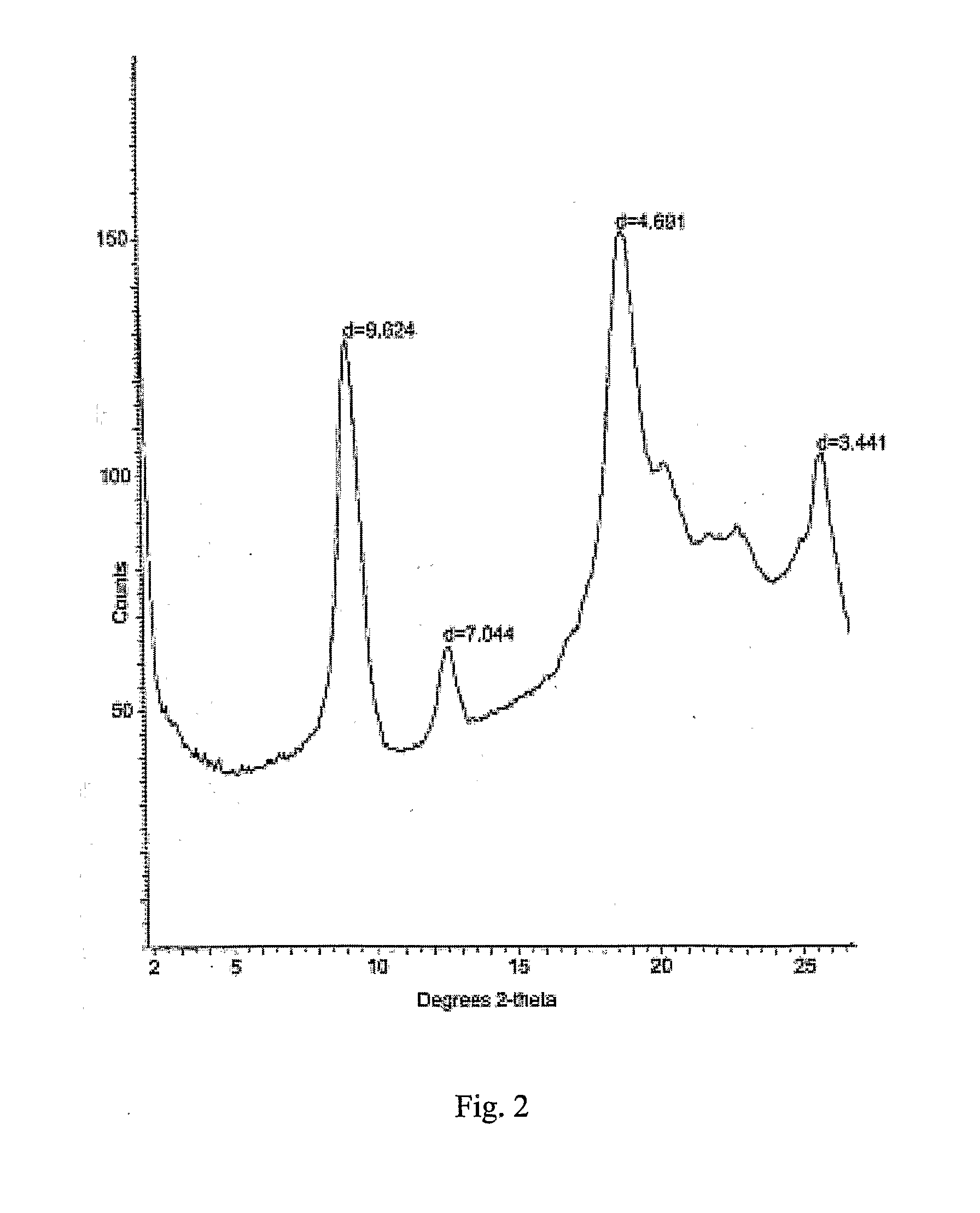Spray-dried chitin nanofibrils, method for production and uses thereof
a technology of chitin nanofibrils and spray-dried chitin, which is applied in the preparation of sugar derivatives, pharmaceutical non-active ingredients, aminosugars, etc., can solve the problems of nanofibril aggregation, heat treatment, and even irreversible aggregation, and achieves faster and less expensive process times.
- Summary
- Abstract
- Description
- Claims
- Application Information
AI Technical Summary
Benefits of technology
Problems solved by technology
Method used
Image
Examples
example 1
Nanofibrils Preparation by Spray-Drying
[0081]10 g Katakura chitin are placed in a flask containing 0.3 M HCl (300-800 ml). Content of the condensing section-equipped flask is boiled for 90 min. During cooling, chitin settles on flask bottom; this facilitates the removal, by means of a pump, of HCl in excess (about 200-600 ml, containing no chitin after dialysis).
[0082]From the flask, the chitin and the scarce hydrochloric supernatant are poured into a glass, reconstituting their initial volume of 300-800 ml with water. This suspension is dialyzed for 20 hours against water: three changes of water, initial weight: 845 g; final weight: 873 g; final pH of 3.3, become 4.2 after water addition. This suspension is centrifuged at 3000 rpm to sediment large-sized chitin particles: the supernatant containing the nanofibrils in suspension is sent to the spray-dryer by means of a peristaltic pump. The chitin particles are instead recovered with fresh 3 M hydrochloric acid and treated again.
[00...
example 2
Formulation of Nanofibrils with Chitosan Glycolate and Sodium Hydroxymethylglicinate, and / or Sodium Glycinate
[0084]Sodium hydroxymethylglycinate (50%) is an antimicrobial useful for cosmetic formulations, produced by Sutton, NJ, USA (CAS no 70161-44-3).
[0085]0.3 M HCl (5.5 ml) is added to 50% sodium hydroxymethylglicinate (10 ml) to adjust its pH, which from 11 becomes 7 (neutral hydroxymethylglicinate).
[0086]Chitosan powder (3 g) is wetted in 45 ml water, and glycolic acid (1368 mg) is added. This solution is divided into 6 aliquots of about 7.5 g (each one containing 0.5 g chitosan, 7.5 ml water and 228 mg glycolic acid).
[0087]1) To the first aliquot of chitosan glycolate it is added neutral hydroxymethylglycinate (85 microliters) prediluted in water (2.5 ml); final pH of 4.5.
[0088]2) To the second aliquot it is added neutral hydroxymethylglycinate (170 microliters) prediluted in water (2.5 ml); final pH of 4.8.
[0089]3) To the third aliquot it is added neutral sodium glycinate (17...
example 3
Dibutyril Chitin-Based Semisynthetic Polymers with Chitin Nanofibrils
[0098]A clear colourless solution is prepared by mere mixing of dibutyryl chitin (36 mg) into ethanol (2 g). This solution is evaporated in a glass Petri dish, yielding a transparent and mechanically resistant film of 2.5 cm in diameter. Analogous solution is added with spray-dried chitin nanofibrils (20 mg), immediately yielding a suspension that does not settle within the time interval required for preparing the film: this suspension is evaporated in a Glass Petri dish, yielding a white and mechanically resistant film of 2.5 cm in diameter. The same operation attempted with lyophilized chitin nanofibrils does not succeed, as it is impossible to obtain a suspension.
PUM
| Property | Measurement | Unit |
|---|---|---|
| temperature | aaaaa | aaaaa |
| temperature | aaaaa | aaaaa |
| length | aaaaa | aaaaa |
Abstract
Description
Claims
Application Information
 Login to View More
Login to View More - R&D
- Intellectual Property
- Life Sciences
- Materials
- Tech Scout
- Unparalleled Data Quality
- Higher Quality Content
- 60% Fewer Hallucinations
Browse by: Latest US Patents, China's latest patents, Technical Efficacy Thesaurus, Application Domain, Technology Topic, Popular Technical Reports.
© 2025 PatSnap. All rights reserved.Legal|Privacy policy|Modern Slavery Act Transparency Statement|Sitemap|About US| Contact US: help@patsnap.com



